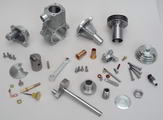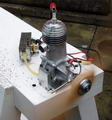Building the
Atom Minor Mk III
by Jan Huning
12. Final Assembly
I used tungsten contact points bought from Hemingway for the contact breaker, silver soldered onto brass mounts, one threaded and the other made for riveting to the spring blade. The tungsten points were turned down to a smaller diameter using a carbide tool after soldering them to the brass mounts.
The taper of the needle valve shown on the drawing is much too steep. I made mine a finer taper, but it is still only 1/2 to 3/4 of a turn open when running.
The engine was assembled without gaskets. I clean all parts in a small ultrasonic cleaner, using the standard cleaning solution (diluted with water) purchased from the supplier of the cleaner. This solution is a powerful degreaser and quite strongly alkali. The parts are then rinsed in hot water and dried. Steel and cast iron parts are straight away wiped with a corrosion inhibiting oil, otherwise they quickly acquire a brown tinge of iron oxide. The cylinder and particularly the piston stay in the cleaner long enough to ensure all the lapping paste is removed. Before I had the ultrasonic cleaner, parts that were difficult to clean such as crankcase, piston and cylinder, were put in a small pan of boiling water with plenty of washing up detergent for a few minutes, then dried and oiled.
John Maddaford told me that he had made the baffle on the pistons of his engines 1/32" shorter than shown on the drawing and reduced the depth of the combustion chamber in the head by (I think) 1/16" to increase the compression ratio and achieve a running speed of around 7500rpm (not sure what size prop). John also increased the length of the thread on the prop driver. I'm sure John said he had made over 30 Atom Minors!
The engine runs nicely on a 12" x 6" wooden prop. I bent the arm for the contact breaker to move it away from the propeller a little. However, ones fingers are still directly in line with the rather hot exhaust when making adjustments to the timing! The whole engine gets very hot when running, too hot to touch, including the aluminium mount. The blowdown period between exhaust ports starting to open and the transfer ports opening is very short, so perhaps some hot exhaust goes into the crankcase. I will try taking a little off the top of the piston on the exhaust side so the exhaust opens a little earlier and the cylinder pressure is lower before the transfer port opens. If it doesn't work, it is easier to make a new piston rather than a new cylinder.
I have tried a number of different oils, all of which worked ok. The first runs were with a semisynthetic two stroke motocycle oil. This oil partially burnt, leaving a rather black residue as seen in the photo of it running. I have since used a straight SAE 50 mineral oil (Aeroshell 100), a lighter weight Shell two stroke mineral oil (Aeroshell Oil Sport Plus 2) and a Stihl chainsaw oil given to me by Eric Offen. These three oils all leave a clean exhaust.
Model Engine News Home
Please submit all questions and comments to [email protected]



